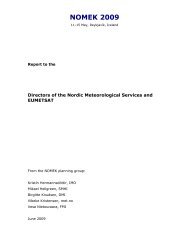International Symposium on Mitigative Measures against Snow ...
International Symposium on Mitigative Measures against Snow ...
International Symposium on Mitigative Measures against Snow ...
Create successful ePaper yourself
Turn your PDF publications into a flip-book with our unique Google optimized e-Paper software.
<str<strong>on</strong>g>Internati<strong>on</strong>al</str<strong>on</strong>g> <str<strong>on</strong>g>Symposium</str<strong>on</strong>g> <strong>on</strong> <strong>Mitigative</strong> <strong>Measures</strong> <strong>against</strong> <strong>Snow</strong> Avalanches<br />
Egilsstaðir, Iceland, March 11–14, 2008<br />
The Icelandic alfa/beta-model provides an approximati<strong>on</strong> for runout distances with annual<br />
probabilities of about 1x10 -2 .<br />
2.3 Security for the transmissi<strong>on</strong> lines<br />
The two transmissi<strong>on</strong> lines pass four different avalanche areas from the power plant to the<br />
aluminum smelter and the transmissi<strong>on</strong> towers in the avalanche areas will be designed to<br />
tolerate avalanches with given return periods and given dimensi<strong>on</strong>s. Three of them, where the<br />
lines run parallel; near the power plant in Fljótsdalur, in Áreyjadalur and above Reyðarfjörður<br />
village, are assumed to have the same acceptable probability of damage of an individual tower<br />
0.5x10 -4 pr. year. The fourth area, between Skriðdalur and Áreyjadalur in Þórudalur and<br />
Hallsteinsdalur, is assumed to have the probability of 1.0 x10 -4 pr. year.<br />
The term damaged is defined as tower hit by an avalanche which acts with higher load than<br />
the design load. It was found that the probability that both of the lines were damaged at the<br />
same time: 0.75x10 -4 for the first area, 2.5 x10 -4 for the sec<strong>on</strong>d area and 2.25 x10 -4 for the<br />
third area. The fourth area, were the lines run in two different valleys, the probability is<br />
calculated to 1.0 x10 -4 . In this case it is not c<strong>on</strong>sidered that the two lines are entirely<br />
independent as the highest risk is c<strong>on</strong>nected with the same extreme event which leads to a<br />
probability of simultaneous damage to both the lines is higher than the product of the<br />
probabilities.<br />
When these results are added together the c<strong>on</strong>clusi<strong>on</strong> is that the probability that both lines are<br />
damaged in the same event is less than 6.5 x10 -4 .<br />
2.4 Determinati<strong>on</strong> of design load<br />
<strong>Snow</strong> avalanches<br />
Design load from the snow avalanche was calculated for the towers and the c<strong>on</strong>ductors. Some<br />
of the research data from Ryggf<strong>on</strong>n, Norway, was taken into account in this work. Force from<br />
an avalanche <strong>on</strong> an obstacle is calculated from:<br />
F = C × p×<br />
A<br />
where:<br />
F: force (N), A: projected fr<strong>on</strong>tal area of an obstacle (m²), C: unitless drag<br />
coefficient, p: dynamic pressure of free stream flow (N/m² or Pa),<br />
Dynamic pressure of free stream flow (DPOFSF) is calculated according to following<br />
equati<strong>on</strong>; it applies over the thickness of dense cores in an avalanche.<br />
1 × v<br />
p1<br />
=<br />
2<br />
ρ<br />
Jónss<strong>on</strong>, Bakkehøi and Haukss<strong>on</strong> 71<br />
2<br />
1











